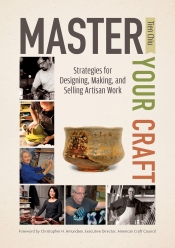 Tien Chiu started blogging her book Master Your Craft: Strategies for Designing, Making, and Selling Artisan Work in 2012. I remember distinctly the day I met her. She had just started blogging her book, and she had come to a California Writers’ Club meeting to hear me speak on the topic of how to blog a book.
Tien Chiu started blogging her book Master Your Craft: Strategies for Designing, Making, and Selling Artisan Work in 2012. I remember distinctly the day I met her. She had just started blogging her book, and she had come to a California Writers’ Club meeting to hear me speak on the topic of how to blog a book.
Since then, I’ve often referenced her website, which was set up so well. It was a great example of how to blog a book successfully. It’s no wonder that she managed to not only complete her blogged book but land a traditional publishing deal for her efforts. And she found a publisher despite the fact that she did not have a large platform or many unique visitors per month.
Master Your Craft helps beginning and intermediate crafters make the leap to master artisan. It outlines a powerful creative process with guidance and useful exercises to help with every step—from the first spark of inspiration to careful contemplation of the finished piece. It also offers advice on driving your artistic growth —developing your skills, finding your “voice,” and (if you choose) making a career in craft.
Chiu blogged Master Your Craft over the course of 11 months at her website www.creatingcraft.com (now repurposed for her coaching business). Almost all of the topics covered in Master Your Craft originally appeared on the book blog but with less detail than in the finished book. She says, “Overall, I would say that 30% of the book content is taken directly from the blog, another 30% is expansions on blog topics, and the remainder is new content, mostly drawn from my interviews with 22 master artisans across a wide range of crafts.”
Read on to learn more about how Chiu blogged her book and landed a traditional publishing deal.
Did you use How to Blog a Book as a guide when blogging your book? If so, what did you find most helpful about the book?
How to Blog a Book was invaluable in blogging my first draft, particularly the advice to outline the entire book beforehand and then establish a regular blogging schedule. Outlining the book beforehand gave me a logical ordering for my blog posts (and a way to know when I was done). And establishing a regular blogging schedule,then announcing it to my readers, forced me to stay accountable. I kept writing, even when I got busy, because I knew my readers were expecting a post every Tuesday and Friday. It helped keep me focused during the 11 months it took to complete the first draft. Without the blog, I would likely have lost interest and given up the project.
How much new content did you later add to your blogged book? Did you plan for this content in advance or was it simply added during the editing process?
Almost 40% of the book is brand-new content, but the content simply elaborates topics that were in the original blog. I had intended to reserve two chapters for the book—“Selling Your Work” and another chapter featuring interviews with master artisans. But after interviewing a few of the artisans, I realized the interviews were far too interesting to banish to just one chapter. So I incorporated quotes from their interviews throughout the book.
How much editing was necessary to complete your blogged book and make it flow? Did you run into any problems particular to blogging a book?
I spent almost a year editing the book. The blog posts had to stand on their own, so each blog topic had a (short) introduction and conclusion. So when I strung the blog topics together, the writing felt very choppy.
Editing mostly consisted of integrating the blog topics so they flowed naturally into a single chapter, and restructuring the content so the chapters flowed naturally together. I also spent a lot of time polishing the prose.
The book’s content is similar to the blog’s, but the quality, style, and tone are much better than in the blog.
Did you take your readers comments into account before the manuscript went to press.
I did take comments into account, but mostly I relied on input from my beta readers once I started writing the manuscript. The blog never got much traffic, so there weren’t many comments.
How did blogging a book make you a better writer?
Blogging a book made me a better writer by helping me establish a regular writing habit. That doesn’t sound like much, but it’s HUGE. If you’re not writing, you’re not improving your writing skills. Just sitting down and writing several times a week— making a consistent writing practice—gave me plenty of practice time.
Editing the book is where I really learned the most, because I had to scrutinize things like structure, style, and word choice. I became a much better writer during the editing of the book.
How did blogging your book make you a better blogger?
It made me more aware of the structure of a blog post—“hook” at the very beginning, then introduction, then conclusion. Also, it got me into the habit of using photos in my blog posts. I used to write mostly text, now I work really hard to break it up with photos.
What advice would you offer to aspiring writers who might want to turn their blogs into books or blog a book?
Write regularly. Preferably, make a schedule and publish it so you are accountable to your readers, i.e. you show up and do the work every week.
If you don’t have time to blog a book and do enough marketing to drive traffic to the site (I didn’t), blog the book first, then worry about marketing it. It’s ideal if you can do both, but if you have to choose, write the book first. Without that, you’ve got nothing to sell.
Do you have any tips you can offer on blogging books?
First, make yourself accountable to your readers for posting on a regular basis. Sometimes it’s difficult to get your motivation up, but having expectant readers who come by every Tuesday and Friday (or whatever your schedule is) is great. It’s like having a “workout buddy,” someone whose presence will drag you to the gym even if you really don’t feel like exercising your writing skills that day.
Second, be prepared for the long haul. I had innocently thought that after I wrote the book blog, I could just spend a couple months stringing blog posts together and be done with it. In fact, it took me almost three years to get the book published after the blog was done. The first year, I wrote and polished the book proposal and then went looking for a publisher. Once I got a contract, it took ten months to write the book and get it to a publishable quality level. Finally, it spent almost a year in revisions and proofs.
And now that it’s published, I expect to spend another six months to a year (and beyond) scrambling to market the book. The year I spent writing the book blog was just the tip of the iceberg.
That said, my third piece of advice is to do it anyway! The blog and book were a ton of work but intensely meaningful, gratifying work. Seeing my book birthed into the eager hands of my readers was one of the most wonderful moments of my life.
And I grew tremendously as a writer in the course of blogging and editing the book. I’m at least twice as good a writer as I was before I started the book.
What one thing did you do that increased your traffic or brought in more unique visitors?
To be honest, the book blog never got much traffic—about 50 page views/day mostly coming from my email signature or links from my personal blog. If I were to do it again, and had more time/energy to do it, I’d do a lot more to build traffic.
How did your blog-to-book deal come about, and did your blog or blogged book play a part in landing that deal?
I submitted my original book proposal to two publishers with no response. I decided that the proposal needed revamping, did a complete overhaul, and sent it to a third publisher, who picked it up immediately.
The publisher requested that I take down the book blog, so I did. I don’t think the book blog had any real influence, one way or another, mostly because there was so little readership on the blog. However, if I hadn’t written the book blog, I would never have finished the book.
What’s the most important thing a blogger can do to get noticed in the blogosphere and build an author platform or fan base?
Start with good content. Without content, you’ve got nothing. Then, do a lot of guest posts, interviews, and other things to drive traffic to your site. And get people to sign up for your email list. That’s a very powerful marketing tool. I’m starting to collect a mailing list now, but I wish I’d started a lot sooner.
About the Blogger
 Tien Chiu is a nationally recognized, award-winning weaver with over 25 years of experience in fiber arts, and over two decades of of experience in industrial new-product development. She combines both industrial development processes with her extensive artistic experience to create her multidisciplinary textile art.
Tien Chiu is a nationally recognized, award-winning weaver with over 25 years of experience in fiber arts, and over two decades of of experience in industrial new-product development. She combines both industrial development processes with her extensive artistic experience to create her multidisciplinary textile art.
Tien teaches workshops on the creative process in craft, writes regularly for Handwoven magazine, and is a co-founder of Weavolution, the social network for handweavers. She also sits on the Board of Directors at the San Jose Museum of Quilts and Textiles.
When not weaving or writing, Tien enjoys adventure travel, making chocolates, and spending time with her husband Mike. Learn more about her artwork by visiting http://www.tienchiu.com, and about her writing by visiting http://www.creatingcraft.com.

Leave a Reply